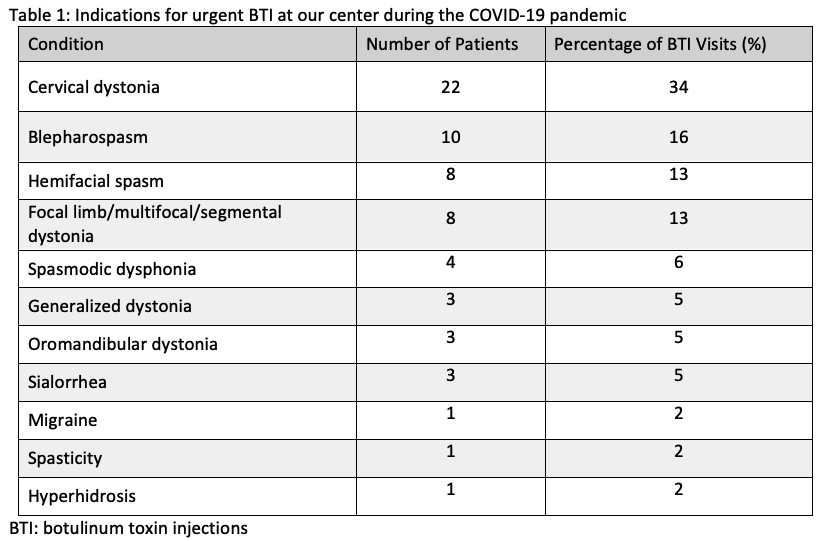Category: Dystonia: Clinical Trials and Therapy
Objective: To report on patterns of patients presenting to our center for botulinum toxin injections during the height of the COVID-19 pandemic in New York City.
Background: In response to the rapid escalation in COVID-19 cases, our movement disorders center canceled all non-urgent appointments from March 13th to May 18th, 2020 and converted them to telehealth. We continued to see patients in-person for urgent indications, including botulinum toxin injections (BTI) and other procedures.
Method: Patients requesting in-person appointments were contacted beforehand to screen for COVID-19 symptoms, verify the urgency of the visit, and discuss risks versus benefits of coming in for care. To minimize risk of disease transmission, BTI were performed under full PPE with the injector wearing a N95 mask, face shield, hair cover, gown, and gloves; additionally, all patients wore face covers whenever possible, and patients receiving facial injections were advised not to speak.
Results: During this period, our movement disorders center saw 327 patients, including 219 telehealth encounters (67%) and 108 urgent in-person visits (33%). 64 of the 108 in-person visits were for BTI, comprising 57% of in-person visits and 19% of all patients. The most common condition for which patients presented for BTI was cervical dystonia (22 patients, 34% of all BTI), followed by blepharospasm (10, 16%), hemifacial spasm (8, 13%), and focal/multifocal/segmental dystonia (8, 13%) (Table 1). Of the patients presenting for cervical dystonia, 20 (91%) complained of posturing, but only 12 (55%) reported pain. [table1]
Conclusion: That so many patients requested to come for BTI during a pandemic is testament to the degree of disability caused by these disorders and the benefit patients derive from treatment, and underscores the need to prioritize treatment of these disorders. These findings are particularly surprising given that only 55% of our patients with cervical dystonia complained of pain. Although there is no standard protocol for performing BTI for movement disorders during a pandemic, we suggest performing these procedures under full PPE may be a safe option, as has previously been proposed for BTI for chronic migraine [1]. Further research should be done to clarify patients’ rationales for requesting urgent appointments for BTI and identify potential predictive factors.
References: 1. Santos-Lasaosa S, Porta-Etessam J. OnabotulinumtoxinA infiltration and nerve blocks in patients with headache and neuralgia: safety recommendations to prevent SARS-CoV-2 infection. Neurologia 2020. 35: 291–4.
To cite this abstract in AMA style:
B. Dorfman, M. Velickovic, W. Tse. Botulinum Toxin Injections For Movement Disorders During the COVID-19 Pandemic: A Single-Center Experience [abstract]. Mov Disord. 2021; 36 (suppl 1). https://www.mdsabstracts.org/abstract/botulinum-toxin-injections-for-movement-disorders-during-the-covid-19-pandemic-a-single-center-experience/. Accessed April 21, 2025.« Back to MDS Virtual Congress 2021
MDS Abstracts - https://www.mdsabstracts.org/abstract/botulinum-toxin-injections-for-movement-disorders-during-the-covid-19-pandemic-a-single-center-experience/

